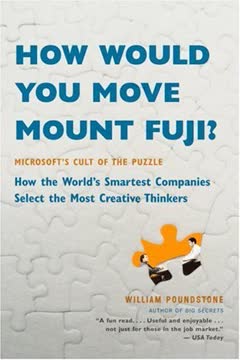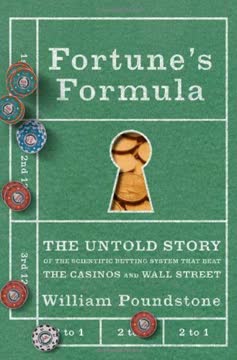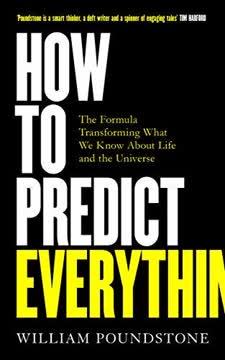Key Takeaways
1. Microsoft's Puzzle Interview: A Quest for Creative Thinkers
Microsoft’s interview process is a notoriously grueling sequence of brain-busting questions that separate the most creative thinkers from the merely brilliant.
Beyond Skills: Microsoft's interview process, renowned for its difficulty, aims to identify candidates who possess original and creative thinking abilities, rather than just assessing their existing skills or knowledge. This approach reflects the company's belief that in the fast-paced tech industry, adaptability and problem-solving skills are more valuable than specific expertise. The goal is to find individuals who can question assumptions, approach problems from novel perspectives, and thrive in an environment of constant change.
The Impossible Question: A key element of the Microsoft interview is the "impossible question," a riddle or hypothetical scenario that has no definitive answer. These questions, such as "How many piano tuners are there in the world?" or "How long would it take to move Mount Fuji?", are not meant to test factual knowledge but rather to gauge a candidate's ability to think on their feet, structure their thoughts, and articulate a logical approach to an ambiguous problem. Interviewers often don't know the "correct" answer themselves, emphasizing the process over the outcome.
A Broader Trend: The puzzle-laden job interview, once unique to tech companies, has now infiltrated various sectors, including finance, consulting, and even the armed forces. This trend reflects a broader shift towards valuing adaptability and problem-solving skills in an increasingly uncertain and competitive global marketplace. Companies are seeking employees who can think critically, question assumptions, and innovate in the face of constant change.
2. The Historical Roots: From IQ Tests to Silicon Valley
No one has done more to define intelligence and make mental assessments a part of hiring than Stanford psychologist Lewis M. Terman (1877–1956).
Lewis Terman's Legacy: The concept of intelligence testing in hiring can be traced back to Lewis Terman, a Stanford psychologist who popularized the IQ test and advocated for its widespread use in schools and workplaces. Terman believed that intelligence, defined as the ability to reason abstractly, could be measured and used to match individuals to suitable jobs, creating an ideal meritocracy. His work laid the foundation for the use of standardized tests in employment decisions.
Shockley's Semiconductor and the Puzzle Interview: William Shockley, a pioneer in transistor technology and founder of Shockley Semiconductor Laboratory, incorporated intelligence tests and logic puzzles into his hiring process in the 1950s. He sought to recruit the most talented engineers and scientists, believing that problem-solving ability was crucial for success in the rapidly evolving field of semiconductors. This early adoption of puzzle-based interviews in Silicon Valley contributed to their later popularity in the tech industry.
The IQ Disenchantment: Despite the initial enthusiasm for intelligence testing, concerns about cultural bias and discriminatory practices led to a decline in their use in hiring. However, the underlying desire to assess cognitive abilities persisted, leading to the adoption of puzzle interviews as a seemingly more egalitarian and relevant alternative. These interviews aimed to measure "bandwidth," inventiveness, and creative problem-solving skills, rather than relying on traditional measures of intelligence.
3. Bill Gates's Puzzle Obsession: Shaping Microsoft's Culture
The family of Seattle attorney William Gates II was a big believer in organized fun.
Games and Competition: Bill Gates's upbringing fostered a love for games, puzzles, and intellectual competition. His family emphasized organized fun, with regular tournaments of bridge, Password, and trivia games. This competitive spirit carried over into his leadership at Microsoft, where a culture of one-upmanship and a relentless pursuit of winning permeated the company's ethos.
Math Camp Mentality: Microsoft's internal culture, often described as "math camp," valued intelligence, logic, and problem-solving abilities above all else. Employees were expected to be highly competitive, constantly striving to outsmart their rivals and push the boundaries of innovation. This environment fostered a unique blend of intellectual rigor and playful competition, with practical jokes and whimsical games serving as both a respite from and a concentrated form of the company's pressures.
The Innovator's Dilemma: Microsoft's leadership, including Gates, has long been preoccupied with the fear of becoming complacent and being overtaken by disruptive technologies. This paranoia, fueled by Clayton Christensen's "The Innovator's Dilemma," has driven the company to prioritize innovation and seek out individuals who can challenge assumptions, adapt to change, and solve complex problems creatively. The puzzle interview became a key tool in this quest for talent.
4. Decoding the Puzzles: Types and Examples
Microsoft’s interview questions are intended to be secret.
Beyond Traditional Questions: Microsoft's interviews go beyond traditional and behavioral questions, incorporating brainteasers, trick questions, and open-ended hypothetical scenarios to assess a candidate's problem-solving abilities and creative thinking. These questions are designed to be challenging and ambiguous, requiring candidates to think on their feet and articulate their reasoning process. The goal is to evaluate how candidates approach complex problems, not just whether they can arrive at the "correct" answer.
Logic Puzzles: A significant portion of Microsoft's interview questions consists of logic puzzles, recreational problems that require deductive reasoning and analytical skills. Examples include:
- "You have eight billiard balls. One of them is 'defective,' meaning that it weighs more than the others. How do you tell, using a balance, which ball is defective in two weighings?"
- "You have a 3-quart bucket, a 5-quart bucket, and an infinite supply of water. How can you measure out exactly 4 quarts?"
Impossible Questions: Another type of question involves estimating quantities or solving hypothetical problems that seem impossible to answer with certainty. Examples include:
- "How many piano tuners are there in the world?"
- "How long would it take to move Mount Fuji?"
Design Questions: These questions ask candidates to design a product or system, such as a microwave oven controlled by a computer or a spice rack for a blind person. The goal is to assess the candidate's ability to think creatively, consider user needs, and make trade-offs.
5. The Cognitive Science of Puzzles: Embracing Cluelessness
To understand that cleverness can lead to stupidity is to be close to the ways of Heaven.
Solution Spaces and Clueless Plateaus: Cognitive scientists like Herbert Simon and David Perkins have studied problem-solving processes, highlighting the importance of searching a "solution space" and navigating "clueless plateaus." Simon believed that problem-solving involved a rational search for solutions, while Perkins emphasized the role of intuition and persistence in overcoming uncertainty. These perspectives offer insights into the cognitive skills that puzzle interviews aim to assess.
Uncertainty and Disjunction: Many puzzles exploit the human tendency to avoid uncertainty and disjunction, the either-or situation where exactly one of two or more mutually exclusive possibilities is true. People often struggle to reason from uncertain premises, preferring to focus on known information. Overcoming this cognitive bias is crucial for solving many logic puzzles and real-world problems.
The Framing Problem: The "framing problem" in AI refers to the difficulty of knowing what is relevant to a given situation and what can be safely ignored. Similarly, many puzzles are designed to exploit faulty assumptions and require solvers to reframe the problem by questioning their initial premises. This ability to step back, analyze assumptions, and consider alternative perspectives is a key skill for innovators and problem-solvers.
6. Wall Street's Adoption: Stress and the Absurdist Interview
“Let’s play a game of Russian roulette,” begins one interview stunt that is going the rounds at Wall Street investment banks.
From Tech to Finance: The puzzle interview, initially associated with tech companies like Microsoft, has spread to other industries, including Wall Street. Investment banks and consulting firms have adopted these techniques to assess candidates' problem-solving abilities, stress management skills, and ability to think on their feet. This adoption reflects the increasing complexity and fast-paced nature of the financial industry.
The Stress Interview: Wall Street firms are known for their "stress interviews," which aim to put candidates under pressure to see how they react. These interviews may involve silence, personal attacks, or absurd scenarios, such as asking the candidate to open a window in a skyscraper office where the windows don't open. The goal is to assess how candidates perform under pressure and whether they can maintain composure in challenging situations.
The Absurdist Interview: Some companies have taken the puzzle interview to extremes, incorporating bizarre tasks and questions that seem to have little relevance to the job. These "absurdist interviews" may involve building something out of Lego blocks or defining the color green. While these techniques may be intended to assess creativity and problem-solving skills, they often come across as arbitrary and demeaning.
7. Navigating the Labyrinth: Strategies for Success
If this appears a paradox, it is only because these interviews have been touted as being difficult or impossible to “prepare” for.
Know the Game: While puzzle interviews may seem unpredictable, there are certain patterns and strategies that can help candidates improve their performance. Understanding the types of questions, the underlying cognitive tricks, and the unspoken expectations of the interview can give candidates a significant advantage. Preparation is key to success.
Key Strategies:
- Determine the expected answer type (monologue or dialogue)
- Assume the first thought is wrong
- Avoid calculus and overcomplicating
- Recognize "perfectly logical beings"
- List assumptions and challenge them
- Lay out possible scenarios
- Give original answers
The Challenge: Be prepared for the "Challenge," a technique where the interviewer argues with a candidate even when they are correct. The goal is to assess the candidate's ability to defend their position, persuade others, and remain confident in their knowledge.
8. Reimagining the Interview: A Proposal for Innovation-Driven Companies
The strongest argument for puzzle interviews is that everything else is worse.
Focus on Negative Screening: Puzzle interviews are most effective as a negative screen, identifying candidates who lack essential problem-solving skills or the ability to think critically. They should not be used as a primary means of identifying "geniuses" or making hiring decisions based solely on puzzle-solving ability. The goal is to avoid bad hires, not necessarily to find the "perfect" candidate.
Fairness and Transparency: Interviewers have a responsibility to ensure that the interview process is fair and transparent. This involves explaining the purpose of the questions, avoiding biased or discriminatory practices, and providing candidates with clear expectations. The goal is to create a level playing field where all candidates have an opportunity to demonstrate their abilities.
Beyond Puzzles: While puzzles can be a useful tool, they should not be the sole focus of the interview. It is important to assess candidates' experience, skills, and personality through a variety of methods, including traditional and behavioral questions. The goal is to gain a holistic understanding of the candidate's potential and fit within the company culture.
Last updated:
FAQ
What's How Would You Move Mount Fuji? about?
- Interview Techniques: The book delves into Microsoft's unique interview process, which uses logic puzzles and brainteasers to evaluate candidates' problem-solving skills.
- Corporate Influence: It examines how these methods have shaped hiring practices in various industries, including tech and finance.
- Creative Thinking: The book provides insights into identifying talent and fostering creative analytical thinking in business environments.
Why should I read How Would You Move Mount Fuji??
- Understanding Hiring Trends: Gain insights into the evolving landscape of job interviews and the increasing use of puzzles in hiring.
- Improving Interview Skills: Offers strategies for both candidates and interviewers to effectively navigate challenging interview processes.
- Valuable Insights: Provides examples and insights that can enhance your approach to problem-solving in professional settings.
What are the key takeaways of How Would You Move Mount Fuji??
- Puzzle Interviews: Emphasizes the importance of puzzle interviews in assessing creativity and problem-solving skills.
- Cognitive Tricks: Highlights cognitive tricks and biases, such as the disjunction effect, that can affect puzzle-solving.
- Preparation Strategies: Offers practical advice for candidates on preparing for and excelling in puzzle interviews.
What are the best quotes from How Would You Move Mount Fuji? and what do they mean?
- Puzzle-Solving Value: “Like any other value, puzzle-solving ability proves equivocal in application.” This suggests that while valued, puzzle-solving skills' effectiveness varies by context.
- Impossible Questions: “The impossible question is one phase of a broader phenomenon.” Reflects a shift in hiring practices towards seemingly unanswerable questions.
- Hiring Importance: “The most important thing we do is hire great people.” Highlights the critical role of hiring in a company’s success.
How does How Would You Move Mount Fuji? explain the concept of the "disjunction effect"?
- Cognitive Bias: The disjunction effect refers to difficulties in reasoning from uncertain premises, often leading to incorrect conclusions.
- Example in Puzzles: Illustrated through puzzles where candidates must consider multiple possibilities, showing how uncertainty can hinder problem-solving.
- Interview Importance: Understanding this effect helps candidates navigate ambiguous interview questions and think through various scenarios.
What types of puzzles are discussed in How Would You Move Mount Fuji??
- Logic Puzzles: Includes puzzles testing reasoning skills, like "How many piano tuners are there in the world?"
- Hypothetical Questions: Features scenarios requiring creative thinking, such as “If you could eliminate one U.S. state, which would it be?”
- Design Questions: Discusses design-oriented questions assessing critical thinking about practical problems, like designing a computer-controlled microwave.
How does How Would You Move Mount Fuji? suggest improving interview techniques?
- Structured Approach: Recommends structured interviews where all candidates are asked the same questions for fairness and consistency.
- Focus on Fairness: Stresses the importance of fairness in questioning, ensuring equal opportunities for candidates to demonstrate abilities.
- Avoiding Trick Questions: Advises against trick questions that may confuse candidates and not provide useful hiring information.
What strategies does How Would You Move Mount Fuji? suggest for candidates facing puzzle interviews?
- Recognize Question Types: Identify whether a question requires a monologue or dialogue, adjusting your approach accordingly.
- Challenge Assumptions: List assumptions and consider rejecting each one to gain new insights.
- Practice Problem-Solving: Engage with various puzzles and riddles beforehand to become more comfortable and adept during interviews.
What is the significance of the title How Would You Move Mount Fuji??
- Metaphor for Challenges: Serves as a metaphor for complex challenges in hiring and problem-solving within innovative companies.
- Encouraging Creative Thinking: Encourages creative thinking about solutions to seemingly impossible problems, reflecting the mindset needed in tech industries.
- Cultural Reference: The reference to Mount Fuji adds depth to the discussion of challenges in a global context.
How does How Would You Move Mount Fuji? address the effectiveness of puzzle interviews?
- Negative Screening Tool: Argues that puzzle interviews primarily serve as a negative screen to avoid bad hires rather than identify the best candidates.
- Comparison with Traditional Interviews: Suggests puzzle interviews may be more effective than traditional ones, which often rely on gut feelings.
- Need for Adaptation: Emphasizes that puzzles should be adapted to fit job-specific needs and company culture.
What is the significance of Bill Gates in How Would You Move Mount Fuji??
- Cultural Influence: Gates is portrayed as pivotal in shaping Microsoft’s interview culture, emphasizing intelligence and problem-solving.
- Personal Anecdotes: Shares anecdotes about Gates’ competitive nature and love for puzzles, reflecting the company’s ethos.
- Hiring Philosophy: Gates’ belief in the paramount importance of intelligence in hiring decisions is a recurring theme.
How does How Would You Move Mount Fuji? address the use of logic puzzles in interviews?
- Assessment Tool: Discusses how logic puzzles can effectively gauge a candidate's problem-solving skills and creativity.
- Limitations of Puzzles: Highlights limitations, particularly for experienced candidates who may find them irrelevant or unfair.
- Guidelines for Use: Provides guidelines for using puzzles effectively in interviews to ensure they yield useful insights.
Review Summary
How Would You Move Mount Fuji? explores Microsoft's use of puzzles in interviews, offering insights into the pros and cons of this approach. Readers appreciate the book's historical context, practical advice for both interviewers and interviewees, and the collection of interesting puzzles. While some find it dated, many still find value in its discussion of analytical thinking and problem-solving techniques. The book receives mixed reviews, with some praising its entertainment value and others criticizing its narrow focus or questioning the effectiveness of puzzle interviews.
Similar Books



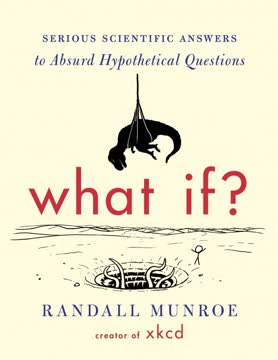
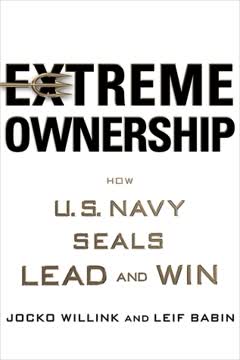

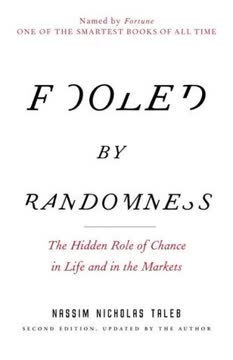
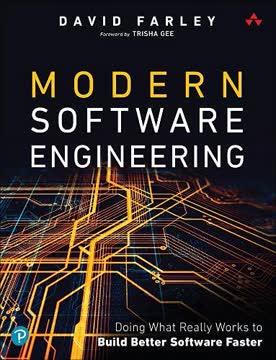


Download PDF
Download EPUB
.epub digital book format is ideal for reading ebooks on phones, tablets, and e-readers.
